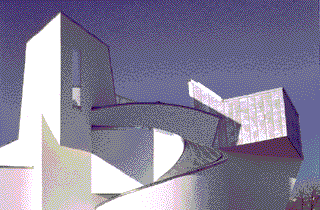
Examples of the work of Frank O. Gehry
concepts: to explore the possibilities of functional and expressive form within strict material and process limitations.
professional: to draw connections between the design professions such as architecture, industrial design, and fine art.
1. Before coming to class read the discussion on Structures for Unit VII in 3D matrix. Review the Project References above.
Activities (choose one):
a) Using no more than 16 square feet of cardboard, design and build the tallest structure you can. It must stand on its own.
b) Using no more the 16 square feet of cardboard, design and build a structure that can support the combined weight of three people from the class at least 18 inches off the ground.
c) Using no more than 16 square feet of cardboard, design and build a functional piece of furniture.
Considerations:
--Use all of your material.
--Make the connections and/or material that holds your piece together part of the design.
--Consider the final surface and color of your sculpture.
--Make a structure that is both functional and beautiful.
1. Describe the techniques used to create the sculptures and explain how various aspects of the problem were addressed such as efficient use of material choice, how the piece "fits" together, the overall design of the sculpture.
2. Is there evidence that the artist engaged a design process that explored different alternatives and refined the initial ideas?
3. Discuss ideas the artwork seems to communicate. After some sharing of interpretations, attempt to state the "message" of the design in one sentence. (This artwork is about. . .)
1. Evidence of your research (print-outs from magazines, web searches, interviews with artists, etc.).
2. Your design process (documentation of original object, method used to move between scales, drawings, computer-printouts, photos).
3. Supplemental materials (receipts, notes about technique or materials)
4. Documentation of the final work.
